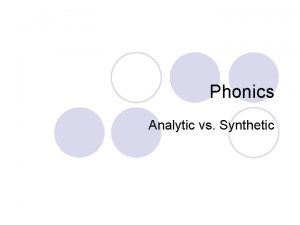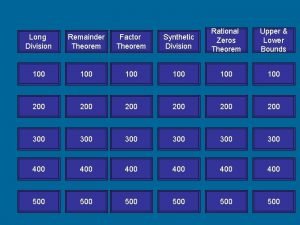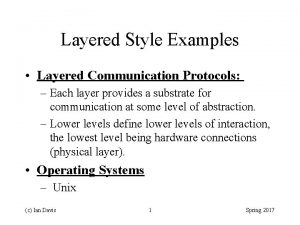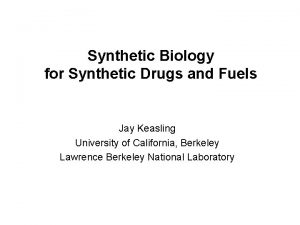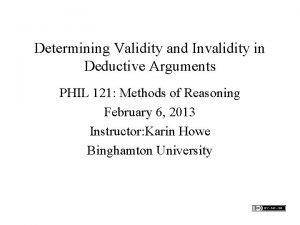Layered Synthetic Diffractors and the Invalidity of the













- Slides: 13

Layered Synthetic Diffractors and the “Invalidity of the Bragg Equation” John Fournelle Eugene Cameron Electron Microprobe Lab Department of Geology & Geophysics University of Wisconsin-Madison

Layered Synthetic Diffractors Layered Synthetic Materials Layered Diffraction Elements Multilayered Diffractors “Pseudo Crystals”

Pseudocrystals/LSMs Goldstein et al. 2 nd Edition, p. 280

Issues with layered synthetic diffractors: J They give high count rates J Peak/background ratios are good J 2 nd order peaks are weak and 3 rd and above >99% suppressed J Peak shift/shape effects muted K Poor spectral resolution (wide peaks) with interferences common K Relative difference of refraction of longer wavelength (1 st order) lines compared with higher order (shorter wavelength) interferences, is greater here than in the smaller 2 d crystals, making Siegbahn’s modification of Braggs’ Law critical

Crystals and LSMs on one Electron Microprobe (UW-Madison SX 51 #485)

A historical note: After the Braggs published their results in 1913 -14, Siegbahn, Stenstrom and Hjalmar found that higher resolution spectroscopy indicated that while Braggs’ equation was very close for 1 st order lines, there were systematic deviations with higher order line locations.

Or replacing d’ we have the familiar equation nl = 2 d sinq (1 -k/n 2) k is refraction factor, n is order of diffraction

“So what difference does this equation make, ” you are asking. I came upon this by accident, in 1998, trying to answer a researcher’s persistent question “How do you know that the 3 rd order P ka peak is totally attentuated by the LDE? ” I did wavescans in both TAP and LDEs, but I was confused — on TAP, the 3 P marker was to the right of F, but on the LDE, 3 P was to the left of F. This made no sense to me. This figure shows schematically the relative positions of the markers for F Ka and 3 rd order P Ka on a wavescan (in sin q or angstroms, increasing to the right) F Ka 3 P Ka F Ka Sin q F Ka=18. 32 Å P Ka=6. 157Å 3 P Ka= 18. 471Å

“The Refraction Effect” … or the Need to use the Corrected Bragg Equation I emailed Stephen Reed. He explained this “cross over” effect being due to the refraction effect…which now I know is taken into account by the Bragg Equation modified by Siegbahn. Here are the calculations that demonstrate the “cross over” for the LDEs. Key is the value of 1 - k/n 2, which is the divisor (=modifier) of theoretical position. F Ka Sin q 3 P Ka

Or look at the effect of varying the refraction factor K on the W/Si 45Å At what value K would F Ka and 3 rd order P Ka fall on exactly the same wavelength for the 45Å LDE? A: 0. 009

How do you know what the 2 d and k are? ? You can trust someone else…. or figure it out yourself. In July 2003 I spoke with Frank Hatfield of Osmic and asked how they calculate 2 d. He said they certify that any multilayer is within ± 3% of its specified 2 d. The 2 d is found by measuring the position of the ‘main X-ray’ of the multilayer and solving for the 2 d in the Bragg equation. I asked about how they determined ‘K factor’ and he had no answer. Well, the K factor does matter — although one could get along with erroneous values as long as there is no inquisitiveness about higher order interferences on ones layered synthetic diffractors.

Here is my first cut at figuring out the 2 d and K values of my LDEs: the assumptions are that the crystals have been reasonably well aligned by the Cameca builder. There are two unknowns, and below the K is varied to find an average 2 d that is similar to the value marked on the side of the LDE. The next iteration is to find a 2 nd order reflection near a first order line and verify that the above K value is correct.

Summary 1. For LDE’s, the precise form of Bragg’s Law as modified by Siegbahn should be understood and used. 2. The K-values can be relatively easily determined, and should be done so, both to keep the vendors honest and to have peace of mind.
 Layered architecture for web services and grids
Layered architecture for web services and grids Polynomials theorem
Polynomials theorem How to write remainder in synthetic division
How to write remainder in synthetic division Long division rational functions
Long division rational functions Synthetic vs analytic phonics
Synthetic vs analytic phonics Synthetic bible study method
Synthetic bible study method Syntheic divison
Syntheic divison Synthetic division remainder
Synthetic division remainder Metamorphic rocks with a layered or banded look are called
Metamorphic rocks with a layered or banded look are called Spread filling
Spread filling Layered structure in os
Layered structure in os Operating system
Operating system Layered kernel
Layered kernel What is layered structure of operating system
What is layered structure of operating system




